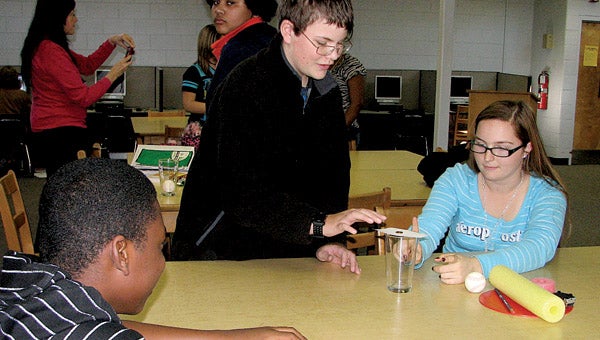Concepts in motion
Published 10:27 pm Friday, January 13, 2012

John F. Kennedy Middle School eighth grader Christopher DeFreeuw, center, performs an experiment exploring force while his classmates, Jordan Moser, left, and Stasha Waterfield, observe. John F. Kennedy students did a variety of activities Thursday to explore Isaac Newton’s laws of motion with help from a Virginia Sports Hall of Fame and Museum employee.
Eighth grader Kier Askew has been on plenty of roller coasters in her life. She’s climbed up the hills just to plummet down them and was jolted when the car stopped back at the station.
But in all of her rides, she admits, she never once thought about the science that goes into the thrill rides.
“It’s really interesting, “ she said. “You’re like, ‘Wow, it’s that simple.’”
On Thursday, Askew and some of her classmates at John F. Kennedy Middle School learned about basic concepts of physics, performed experiments to study the concepts and even got to build a roller coaster.
Students from all grade levels got the opportunity to participate in hands-on activities studying Isaac Newton’s Laws of Motion with help from the Virginia Sports Hall of Fame & Museum.
Jennifer Barnes, the director of education at the Sports Hall of Fame, visited students from Kathy Applebee’s classes during the morning.
The students experienced the concepts firsthand by doing things like placing a penny on an index card, placed on the top of a cup, and pulling the card to see the penny drop into the cup, demonstrating Newton’s law that an object at rest will stay at rest unless acted upon by an unbalanced force.
Hands-on learning brings concepts to life for students, Barnes said.
“We believe that as children are moving and learning they are going to retain information better,” she said.
Katelyn Creech, an eighth-grader, said the lessons are definitely going to stick with her.
“When you read it in a book, it’s a lot to take in, but when you’re actually doing it, you’ll remember it better,” she said.
After the students practiced the different concepts, they teamed up to build a roller coaster, using plumber’s tubing, rubber mats and marbles.
The objective was to design a coaster with two hills, make the marble move through the coaster and then stop on the mat.
“They were getting it through the roller coaster,” Barnes said. “They just couldn’t get it to stop.”
Applebee said this activity was great for the students, because it was so challenging.
“It’s problem-based learning,” she said. “You have a problem of stopping the marble, and you have to figure out what to do.”
Applebee said she was impressed by the student’s teamwork and critical thinking to achieve their goal.
“You see the wheels turning and the ideas generating,” she said.
The Sports Hall of Fame hosts several programs like the Newtown one at its Portsmouth location, but this is the first time the science program has traveled to a school.
Applebee received a grant from the museum to bring the team to John F. Kennedy, and she said she was glad the students had the chance to experiment.
“Force and motion is sometimes a hard concept to grasp,” she said. “This will stick in their memories. For the rest of the year, I can say, ‘You remember when we were in the library,’ and they’ll remember. You can’t say that about a textbook.
“What they shared is going to have an impact on what goes on in our classrooms for the rest of the year and years to come.”





